You have /5 articles left.
Sign up for a free account or log in.

ckybes/istock/getty images plus
Why do we hear so much debate on college campuses about grade inflation? If a student has worked hard and learned the material in ways that can be confirmed through assessments, exercises and dialogues, why doesn’t that student deserve an A?
Moreover, if that student, working diligently, hasn’t managed to grasp the subject, whose fault is it—theirs or mine? As a professor at a major university, I think my questions should be: Have I explained it in enough ways to clarify and illuminate the material? Have I made the subject worthy of learning? Am I here to teach or to stand by after offering just one way of making a point?
Developmental psychologist Howard Gardner first mentioned multiple intelligences in 1983, and my students provide ample examples of needing many ways to understand what I am conveying. What and how much they learn should be the measure of their achievement and my ability to ensure that achievement—and the grade should reflect that.
President Joe Biden has included early learning in his Build Back Better Act, because it has been proven that going to school at ages 4 and 5 prepares you for school later in life and ensures that you are better equipped for jobs. If a young person does not learn to read in first grade, no one says, “Well, that is the fault of the student—let’s give them a poor grade.” A principal or peers will observe the teacher and coach for improved results. Sometimes the student needs extra care and will thus have an individualized education program generated.
At colleges and universities, however, we leave instructors alone for the most part. We say the classroom is sacrosanct. Institutions provide external centers for teaching excellence, and many of the finest teachers take advantage of the good programs offered. But over time, some keep going and some don’t. Rarely do we have a systematic method of classroom observance to ensure that coaching is a yearly, accepted activity.
Even with ample evidence that students want assessments that enable learning from projects that are active, hands-on learning, many students still take finals and midterms—and for many reasons. For instance, students may need to know facts. They may be in large classes where grading personal essays or projects would be impossible. Still, we could create grading systems that ensure that a poor midterm result doesn’t create a deficit it’s impossible to climb back from if the student does well by semester’s end.
Are we creating critical thinkers in our classroom and making students consider opposite points of view? Do they read what makes them think about an opposing point of view? Do they have to support and understand why listening to all sides of a debate has value?
People have voiced concerns about grade inflation for decades. One 2012 study suggested that so many selective colleges have been inflating grades, and ultimately GPAs, that it is harder to differentiate students when they are evaluated for jobs or admittance to advanced-degree and other programs. Without regulation or stronger grading guidelines, the authors argued, “grades at American institutions of higher learning likely will continue to have less and less meaning.”
But is that such a huge problem? Students graduating from our colleges and universities should be evaluated for jobs or programs on a range of qualities, and grades are just one of them.
The issue is exacerbated due to the fact that students enter colleges and universities with a wide array of backgrounds, knowledge and exposure to information. They come at the learning material from many different perspectives, and that’s a good thing. It reflects the diversity of the student body and the importance of diversity itself.
It also means students enroll in college at many different points in their learning. I teach at Northwestern University in Evanston, Ill., and on its Chicago campus. Many students who enter from nearby New Trier High School in affluent suburban Wilmette will have taken many AP exams, with results ranked in the 96th percentile nationally. In contrast, in Mississippi, less than 20 percent of the students took an AP exam in 2021 and fewer than four out of 10 had a score of 3 or above. Distinguished Senior Fellow and President Emeritus of Thomas B. Fordham Institute Chester E. Finn Jr., who has looked at the relationship of AP placement and geography, notes, “Students from lower-income families are less successful on the end-of-year AP exams. Though nearly half of low-income graduates who take an AP exam during their time in high school receive scores of 3 or higher, nearly two-thirds of their non-low-income peers earn similar scores.” At Northwestern, for example, the entering class is now over 20 percent Pell-eligible, meaning that the at least a fifth of the student body comes from such low-income populations.
In my class, I treasure that hardworking, thoughtful low-income student just as much as I prize the New Trier student, because they are both caught up in the material and are learning from each other and from the rest of the class. But they did not begin from the same starting line, and that’s the point. Teaching is not just about conveying the material but also about differentiating students—being able to recognize specific abilities and tailoring learning to the needs of individuals.
Those are the factors that go into many of the A’s I give out. In one of my classes, I have the students create a presentation on a new innovation. They have to create a business plan for the innovation and present it. Some of the advantaged students have family members who help, have given presentations before, are terrific at presenting and understand financials. Other students meet with me for hours and go to the library, to the one-button studio to view themselves as they rehearse, watch TED Talks on how to present, enlist help from teammates and so forth. In the end, as the students applaud, both novice and more experienced students get feedback that improves their learning and ensures that the assessment is valued. Both deserve an A. But they did not start out at the same place, and the route to the presentation was very different.
One of the constant refrains I hear from my students is their determination that we address inequality in America. Access to good education is one of the ways. Helping them with successful learning outcomes is another. Both ought to help equalize.
If you are a smart and eager student, willing to learn, and you demonstrate you can master or excel at the subject, then I as your instructor should be willing to work very hard to make your learning experience one that is successful and worthy of an A.








